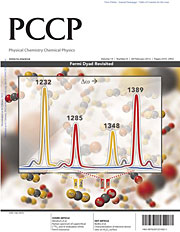- Number 359 |
- March 26, 2012
Toppling Raman shift in supercritical carbon dioxide

Toppling Raman Shift in
Supercritical Carbon Dioxide.
Vibrational mix shines new light
on carbon sequestration
measurements. Image reproduced
by permission of
Battelle and
PCCP
Owner Societies from
Phys. Chem.
Chem. Phys., 2012,
14, 2560-2566,
DOI: 10.1039/C1CP22349F.
Just as a wine glass vibrates and sometimes breaks when a diva sings the right note, carbon dioxide vibrates when light or heat serenades it. When it vibrates, the chemical compound exhibits a vibrational puzzle known as Fermi resonance, first recognized in carbon dioxide and explained by Enrico Fermi in 1931.
Now, researchers studying geologic carbon storage have learned a bit more about the nature of the Fermi resonance in carbon dioxide. This new knowledge can ultimately help scientists interpret spectral lines in complex environments and therefore better understand details in chemical reactions.
To follow supercritical carbon dioxide in chemical reactions, researchers often use Raman spectroscopy, which is a way of capturing a molecule's vibration. By simulating the carbon dioxide molecules with different oxygen isotopes on a computer, researchers at DOE’s Pacific Northwest National Laboratory produced the first Raman spectra ever reported for supercritical carbon dioxide labeled with the isotope oxygen-18.
"We're happy to be able to say something new about something so old," said PNNL chemist and author Dr. Charles Windisch, Jr. "We figured out how the different carbon dioxide molecules are vibrating at some of the Fermi resonance frequencies. And, of course, we can calibrate our data with more accuracy now."
"To this day, people often mark this portion of the CO2 Raman spectra incorrectly," said PNNL computational chemist Dr. Vassiliki-Alexandra Glezakou. "It helps to know what we are looking at, if we are going to use certain bands as guidelines to understand molecular interactions."
Sequestering carbon-based emissions, especially from coal-fired power plants, is vital to managing climate change. For widespread carbon sequestration adoption, complex questions about the permanence of proposed underground reservoirs must be answered, frequently by monitoring chemical reactivity with spectroscopic methods. This fundamental study will add to the scientists' arsenal to answer those questions more efficiently.
[Kristin Manke, 509.372.6011,
kristin.manke@pnnl.gov]
